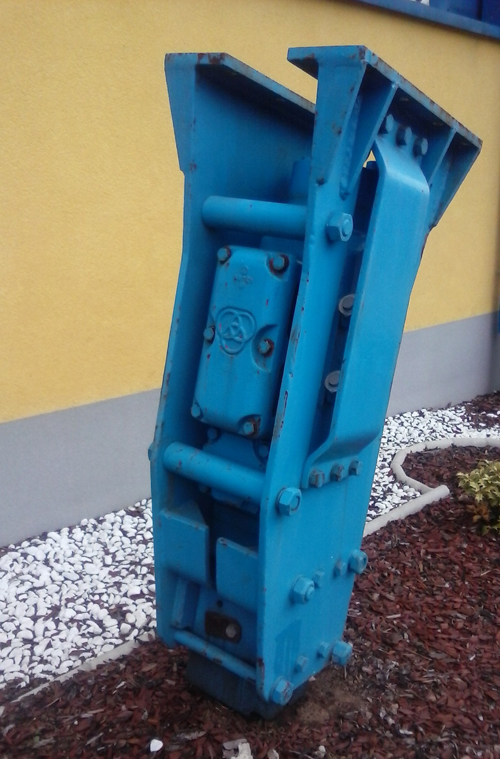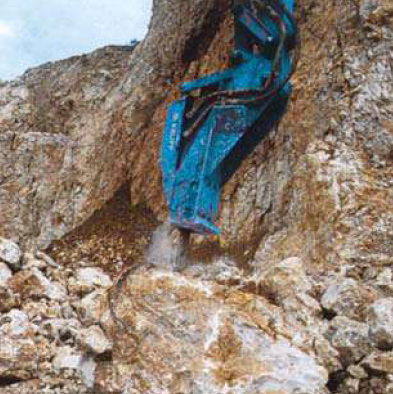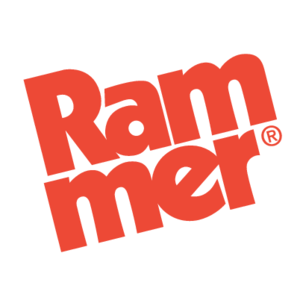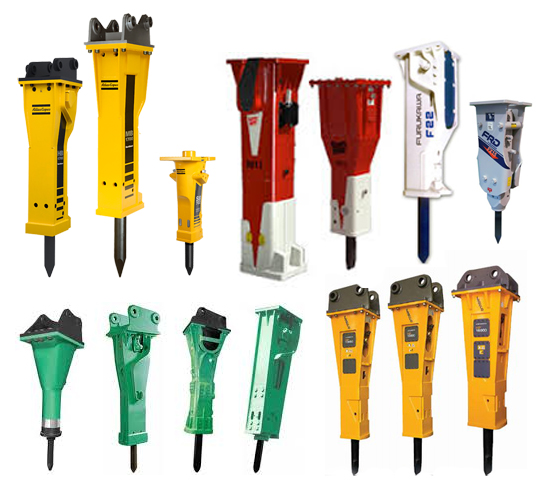Hydraulic hammers
Use of hydraulic hammers
The hydraulic hammer is a powerful hydraulic attachment that is mounted on the carrier and uses the hydraulics of the carrier for its operation. It is mounted on the carrier with a intermediate plate (adapter plate, connecting plate, hanging plate). It is connected to the excavator hydraulics by pressure and return hydraulic hoses.
The basic function of a hydraulic hammer is to concentrate a large impact energy in a relatively small and as light as possible mechanism for the purpose of breaking hard rocks.
The field of application is very wide, and it is most often found in civil engineering for general construction, trenching, secondary breaking, tunneling, underwater operation, etc.
Hystory
KRUPP HM 400 – year 1969. – exhibited in WT grupa
– the hammer is in working condition !

There are various stories of who was the first to produce a hydraulic hammer in the world and, in our experience, it is that manufacturer whose representative, at a given moment, you are talking to.
The fact is that the very concept of hydraulic hammers dates back to the end of the 19th century, but as excavators were not developed at that time, hydraulic hammers were not developed more seriously.
It was only after the Second World War, in which oil and gas accelerators were developed for military purposes, that the application of this technology for commercial purposes began to be considered. Somehow at the same time two companies, in USA - Ingersoll-Rand and in Germany - Krupp are starting to apply this technology to impact mechanisms for hydraulic hammers.
In 1967, almost simultaneously, the first hydraulic hammers of these two companies were introduced to the market. Krupp's first hydraulic hammer from 1967 was the HM 400.
Hammer model KRUPP HM 400 was first exhibited at the Hanover trade fair in 1967. The first practical application of the hammer was in the quarry, in 1968 (see photo below).
This hammer worked until 1987 and is now in a museum in Munich. Another such model is located in front of the WT grupa in Rijeka-Croatia (see photo above).

Brands
Today, there are a large number of hydraulic hammer manufacturers in the world. The largest number of manufacturers can be found in the offer of small hammers with working weights up to 600 kg. As the working weight of the hammer increases, the number of serious manufacturers decreases.
In the world of hydraulic hammer manufacturers (in Europe), when talking about hydraulic hammers, most often mentioned are  Atlas Copco (before KRUPP, now EPIROC), Montabert, Furukawa, Indeco. In addition to these 5 brands in the EU, on the field we can often come across: NPK, DNB, Italdem, Promove, Hammer, Okada, MTB, Komatsu, JCB, CP, CAT, Bobcat, Rotair, Soosan, Stanley, Toku, ...
Atlas Copco (before KRUPP, now EPIROC), Montabert, Furukawa, Indeco. In addition to these 5 brands in the EU, on the field we can often come across: NPK, DNB, Italdem, Promove, Hammer, Okada, MTB, Komatsu, JCB, CP, CAT, Bobcat, Rotair, Soosan, Stanley, Toku, ...
Technology
No matter how many manufacturers there are, basically the working principle of hydraulic hammers is reduced to three main principles:
Oil (for example,  , Montabert, Indeco)
, Montabert, Indeco)
- o Transfer of impact energy to the piston exclusively by oil
- o No nitrogen gas in a back head
- o Almost all models have a gas accumulator (diaphragm), some have two accumulators (low pressure and high pressure)
Gas (for example, NPK)
- o All the impact energy is transmitted to the piston by the gas in the back head
- o Rarer technology
Gas/Oil (for example, Atlas Copco (KRUPP, Epiroc), Furukawa)
- o Impact energy is transmitted to the piston by a combination of oil and gas
- o Nitrogen gas in their back head transmits up to 70% of the impact energy to the piston, and only 30% comes from the excavator oil system
- o They usually have built-in accumulators (diaphragms) on models over 1000 kg of working weight
 , Montabert and Atlas Copco / Krupp / Epiroc have gone the furthest in the development of the impact technology. Most other hammers are either a literal copy of one of these three technologies or a modification of one of these technologies. Many hammers appearing on the market are, in essence, the product of one of the three manufacturers mentioned.
, Montabert and Atlas Copco / Krupp / Epiroc have gone the furthest in the development of the impact technology. Most other hammers are either a literal copy of one of these three technologies or a modification of one of these technologies. Many hammers appearing on the market are, in essence, the product of one of the three manufacturers mentioned.
OEM manufacturer (Original Equipment Manufacturer) | Examples of brands in the market |
Atlas Copco / Krupp / Epiroc | Chicago Pneumatic (CP) JCB (some models) Kubota Penta Breaker (PB) Lifton |
| Case (some models) Caterpillar (some models) JCB (some models) |
Montabert | Bobcat Tramac |
A whole range of manufacturers are developing their own hammers that are very close copies of leading brands, some even producing identical copies of original brands.
For example, Italian manufacturers are known for copying Montabert technology, manufacturers from the Far East have taken over Krupp technology and some from Turkey  technology.
technology.

How to choose a hammer when buying?
In a number of commercial responses, perhaps the most honest answer would be: One that has developed quality after-sales support in your local market - spare parts availability, service and professional staff - directly or through its authorized partners / distributors. Even the most expensive equipment, without quality (or unprofessional) after-sales support, very quickly falls out of operation and loses its function.